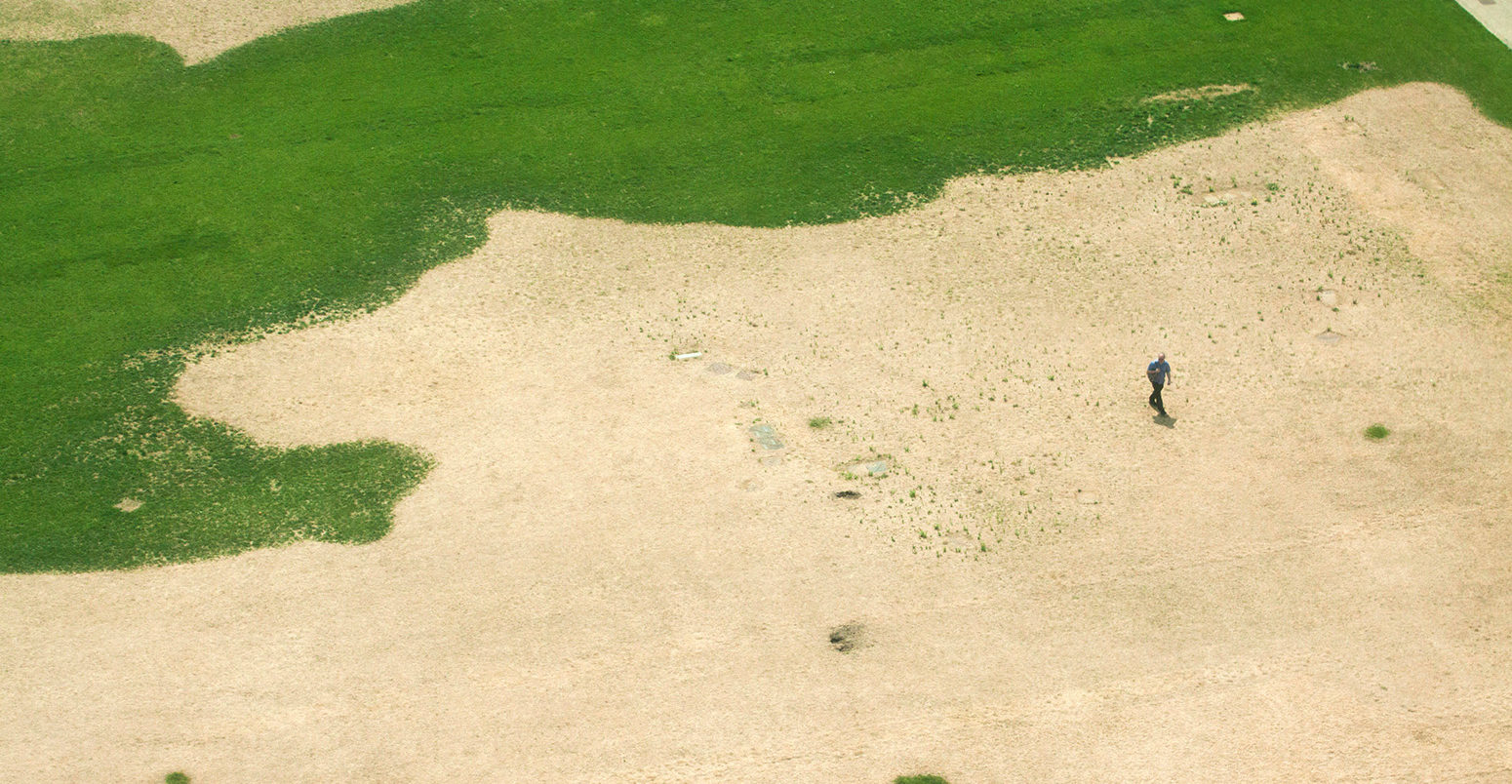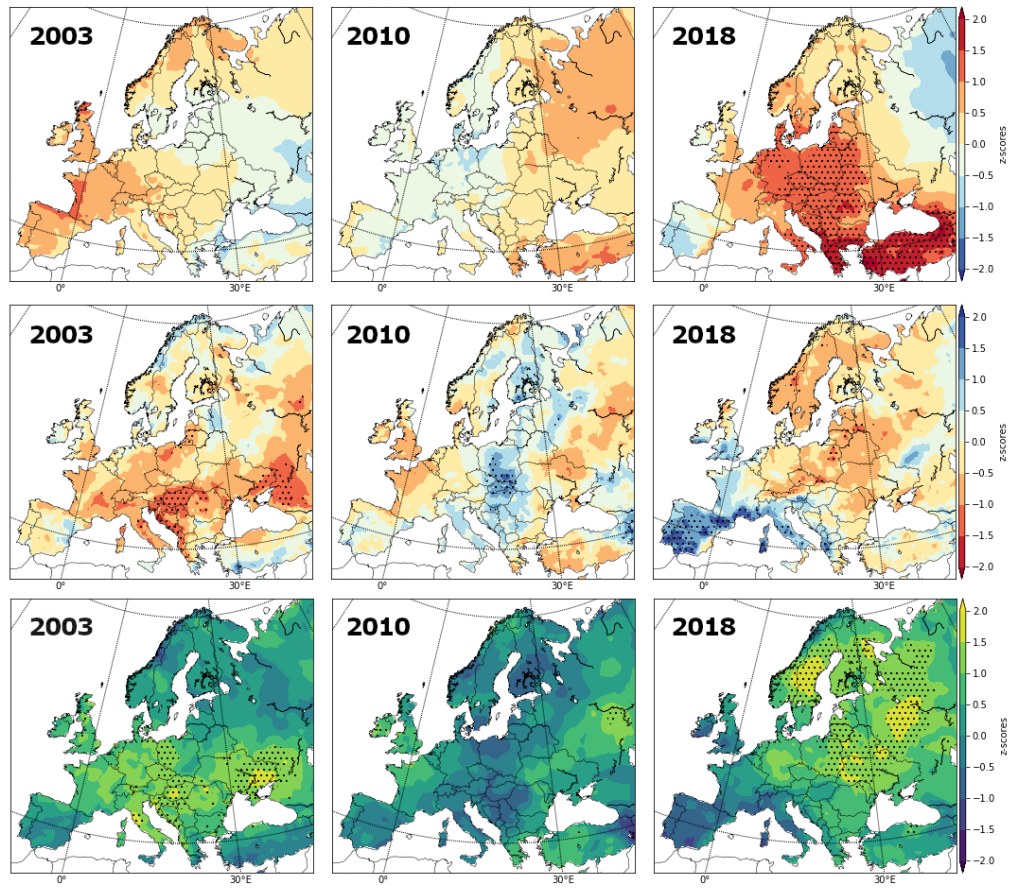
Warm spring worsened Europe’s extreme 2018 summer drought, study says
Daisy Dunne
06.10.20Daisy Dunne
10.06.2020 | 7:00pmEurope’s extreme 2018 summer drought was worsened by an unusually warm and sunny spring in the same year, a new study finds.
Sunny weather in the months preceding the heatwave caused plant growth to accelerate across the continent, which, in turn, led to the fast drying out of soil, the research says.
The dry soil, in combination with record-breaking summer heat, created the conditions for 2018’s extreme drought – which caused millions of pounds of crop damage and fanned wildfires from Greece to the UK.
The findings come as the UK emerges from its sunniest spring on record. This year’s unprecedented sunshine could heighten the risk of another extreme drought in summer, depending on weather conditions in the coming months, the lead author tells Carbon Brief.
Parched
The northern hemisphere’s 2018 summer heatwave dominated frontpages. The extreme heat lasted for months and temperature records were broken simultaneously across North America, Europe and Asia.
At the same time, Europe was plunged into a continent-wide drought, which caused severe crop damage and fanned the flames of wildfires.
A study covered by Carbon Brief found that the summer heat seen across the northern hemisphere in 2018 would have not been possible in a world without human-caused climate change.
The new study, published in Science Advances, is the first to investigate how weather in the months leading up to the heatwave could have contributed to Europe’s extreme drought.
It finds unusually sunny and warm weather in the spring had a lasting “legacy effect” on the land, which then amplified drought conditions in the summer, says Dr Ana Bastos, a group leader at the Max Planck Institute for Biogeochemistry in Germany and lead author of the study. She tells Carbon Brief:
“Spring conditions led to an enhancement of photosynthesis early on in the growing season, but at the cost of strong soil-water depletion. In the crop-dominated areas in central Europe, increased growth in spring made ecosystems more vulnerable to drought in summer.”
Premature plants
For the study, the authors reexamined the weather conditions in Europe in both the spring and summer of 2018. They also looked into weather conditions during two previous European summer heatwaves in 2003 and 2010.
The maps below show mean temperature (top), rainfall (middle) and solar radiation (bottom) across Europe during the spring months of 2003 (left), 2010 (middle) and 2018 (right). On the maps, red signifies above average temperatures or rainfall deficits, while yellow shows above average solar radiation (sunny weather).

The maps illustrate how the spring of 2018 saw unusually warm and sunny weather across much of the continent, when compared to other years experiencing summer heatwaves. Some parts of Europe also saw unusually large rainfall deficits in the spring of 2018, but this was not uniform across the continent.
The authors then investigated how the weather in the spring of 2018 could have affected plant growth – and, subsequently, soil moisture – across the continent.
To do this, they used a set of 11 vegetation models capable of simulating how plant growth responds to changes in climate. Bastos explains:
“We ran three simulations – one with the observed climate conditions for 2018 and two others where spring or summer were replaced by the average conditions of the past 40 years.”
By comparing these scenarios, the researchers were able to work out to what extent the changes in plant growth seen in the 2018 simulation were down to its unique climate conditions in spring and summer.
The results show, in the 2018 simulation, plant growth rapidly accelerated in spring across much of the continent.
This can be viewed in the video below, which shows a timeseries of modelled “gross primary productivity” – a measure of plant growth – across Europe from the beginning to end of 2018. (A running time series of soil moisture is shown beneath the map.)
In the video, bursts of dark green during spring – particularly in April and May – indicate large increases in plant growth.
This accelerated plant growth caused soils to dry out rapidly, Bastos explains:
“In crop-dominated areas in central Europe, increased growth in spring made ecosystems more vulnerable to drought in summer – and resulted in photosynthesis collapse during the summer.”
This collapse can also be seen in the animated map, where spots of dark green suddenly turn to brown in the summer months across countries including France, Spain and the UK.
The collapse in plant growth likely caused large releases of CO2 and widespread crop damage in the summer – amplifying the effects of the summer heat, Bastos says.
Previous research suggests that the likelihood of springtime heat in Europe is expected to increase with climate change, Bastos says:
“With increasing temperatures and atmospheric CO2, vegetation will grow earlier and at a faster pace in spring, which will contribute to earlier soil water depletion and increase the risk of summer droughts.”
It is possible that this year’s record sunshine in spring will lead to extreme drought in Europe, but this will depend on weather conditions in the coming months, she adds.
Tree power
While the accelerated growth of plants in spring worsened the summer drought in most parts of Europe, it had the opposite effect in the Nordic region, Bastos says:
“In the forest-dominated Scandinavia, increased growth in spring helped offset the negative effects of the summer drought.”
This is likely because the Scandinavian landscape is dominated by trees rather than by crops, she says:
“Trees can control water loss by adjusting the opening of pores in their leaves – and have deeper roots than grasses or crop plants. This enables them to use water more economically and to trap the water at greater depths during periods of drought.”
This finding suggests that increasing tree cover in central Europe might help to stave off the impact of spring heat on droughts in future, she says:
“The role of forests in attenuating and mitigating the negative impacts of extreme summers should be considered in future land-management strategies, such as the proposed New EU Forest Strategy and the European Green Deal.”
Overall, the findings are “interesting”, says Prof Sonia Seneviratne, a researcher of climate extremes from ETH Zurich, who was not involved in the study. She tells Carbon Brief:
“These results suggest that the often-hypothesised positive effect of CO2 on plant water efficiency is possibly already being overpowered during strong drought conditions in a large part of Europe.”
Bastos, A. et al. (2020) Direct and seasonal legacy effects of the 2018 heat wave and drought on European ecosystem productivity, Science Advances, https://advances.sciencemag.org/content/6/24/eaba2724

